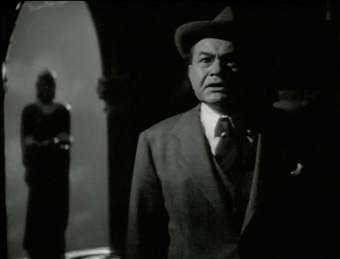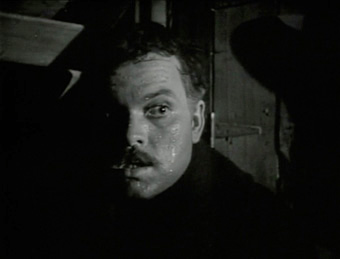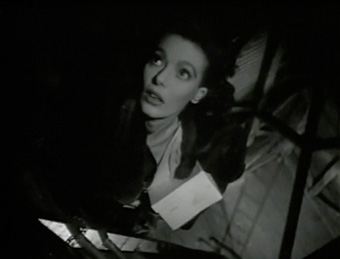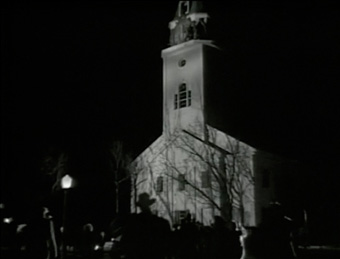| |
"...As for my style, for my vision of the cinema,
editing is not simply one aspect; it's the aspect." |
| |
Orson Welles
(and one of the reasons I adore his work) |
The stalwart, squat and dogged Nazi Hunter, Edward G. Robinson, goes after suave but murderous Nazi bad guy, Orson Welles, in The Stranger, regarded as one of Welles' lesser works. Given that, it's still damn powerful stuff. The year was 1946 and Hollywood directors still directed in those days and not gave up at least one of the reigns to the computer processors. Yet, for all the moody, black and white and frankly stunning chiaroscuro, there is a taut thriller in here by way of Welles artful camera movements, precise use of the optical printer (the CGI of its day) and performances perfectly judged for their era. The intricately cut and shot climax suggests there were other juicy stylized nuggets that got lost along the way and sadly we find this was the case. But in 2009, we may not be shocked by such executive censorship (Welles was too good to be allowed to continue to be so) but inside the movie is a piece of documentary that must have seemed as if it had wandered in from another, significantly hostile, planet.

Shocking is a relative word. Context is all. Imagine going to the cinema in 2009 (let's pretend it's a drama based around the Rwanda massacre of 1994 – after all, there have been a few). Perhaps some ringleaders are being hunted and brought to justice. Suddenly you are shown the result of the genocide in quite explicit detail and one scene of a man about to machetéd to death. Even modern and jaded palettes may baulk at this knowing that the footage was real and no exploitative Hostel 3 plethora of prosthetics. Well, as bizarre as this may sound, audiences in 1946 may have gasped in similar horror six seconds short of an hour in to Orson Welles' third (officially directed) picture. It was the first commercial movie (there was no television) to show the results – and some actuality – of the holocaust. I can imagine a few punters coming out of the cinema – then called 'picture houses' – announcing that it was all done with special effects. Perhaps the scale of it defied belief. There is a lovely moment in Welles' wife's interrogation when Robinson knocks the projector hitting Loretta Young's arm and she recoils as if the machine actually contains the horrors spread out in light before it.
Orson Welles, the quintessential American director with talent pouring out of him like spray off Niagara, was cursed with bad timing. Here was a boy who knew the world was at his feet. He had the colossal self-confidence of almost complete ignorance and was knocking on P.T. Barnum's door for best self-publicist of all time. He upped himself into several careers that saw him famous for being an actor, on both stage and screen, a writer/director and radio performer. But the post-war world of America in the later forties was edging into safer waters on the creative front and every single film Welles made after his debut and all time classic Citizen Kane, save one or at a stretch two, was interfered with and re-cut against his wishes, The Stranger included. Apparently the movie lost a lot of Welles' touches (very likely hugely creative and exciting ones), cut out by producers desperate for 'standard fare' from one of cinema's most dominant talents. But despite the movie's conventional narrative, Welles and his singular skills are still evident even outside of his starring role. You know an Orson Welles directed movie when you see one.
PERSONAL INSERT:
I was lucky enough to be informally taught cinema by my good friend and ex-USC film student and successful Hollywood director, Richard Franklin. His 'big three' were Hitchcock (duh, for anyone that knows Richard's past and career), Ford and Welles. I already knew most of Hitch's work, very little of Ford's save The Searchers and The Quiet Man (both favourites of my father's) and soon caught up but where we parted at first was on Welles. I hated Kane when I saw it because at 14, I had been primed by my English teacher who told me it was the greatest film ever made. Eurgh. Dreary, black and white and about people I couldn't care for. I was devastated. I have since 'refined' that opinion. Richard took me through Welles' oeuvre like a chef knowing his punter will just delight in every morsel, every sip. I remember very dearly the rapt look on seven or eight enthusiastic faces (including Richard's and mine) in a Scottish hotel room in 1985 watching the BBC's rather wonderful The Orson Welles Story, all three hours of it. Despite my youth, I managed to give Richard an insight on one aspect that united each of the 'big three'. Even during camera movements, all three film-makers seemed to have their tripods sealed in cement: Rock solid – in idea, in presentation and in technique. After seeing The Stranger again after many years, I still hold to that.

Welles said of his own career: "I started at the top and have been working my way down ever since." How the 'probable' greatest of them all (OK, OK, of all English language film makers) could direct the marvel that is Kane and decades later be arguing proper English with a director... of a frozen pea commercial... If you know what I mean and have heard it, then the words "In July..." will make you wince. Oh, what a waste. Had Welles been born a few decades earlier and grown into the film industry as it grew up with him, he probably would have died the most famous and feted man in America. As it was, he exploded and fell wheezing and burnt out with the explosion taking a twinkle of second and the rest of his career spreading out over the long run afterwards. Welles was free (in America, naturally) to crash and burn, something he also had a talent for. When he was able to leap off that cliff (when another talent, like Charlton Heston making Touch Of Evil, who demanded Welles' participation in his film noir), no American director soared higher. Film-making was and is ludicrously expensive. Genius is only ever funded when there's a nuclear arsenal at the other end of it. Entertainment? Film making? Meh. Give Einstein the cash. Let Welles howl at the moon.
So, WWII is over and the atrocities of the Nazis are now common knowledge if not commonly believed. America was entering one of its most prosperous periods so cinema was blooming. Nazis had proved to be extraordinarily clear cut and somewhat soulless villains and so the stories of what happened to the instigators of the holocaust spread like venom through veins. Brazil seemed a popular destination but one or two chanced their 'harm' in the US attempting to blend in. Our fictional Nazi bastard, the architect, no less, of the extermination camps, Franz Kindler, is about to be married to a supreme court judge's daughter, Mary, played by Loretta Young – perfect cover. The diminutive and rather wonderfully gruff and real Edward G. Robinson plays the Nazi Hunter, Wilson.
Robinson is complicit in releasing a Nazi criminal, a small born-again lure whom he hopes will lead him to land the biggest catch of his career. Welles is almost gleeful with the camera and we start close over Robinson's wonderful face and sweep backwards and wide, a signature move throughout the movie itself. It has no bumps, no tell-tale judders. It's as if Welles can lay tracks in the air itself. Robinson sets someone to follow the small fry culminating in one of those shots that make you suddenly realise how good this guy was with light. The follower disappears in the target's shadow – she is literally shadowing him. I'm making that Wallace and Gromit gesture with my hands right now.
After an attempt on his life in a gymnasium, Robinson is sure he's at least at the right place, a Norman Rockwell mid-American town with a bell tower which starts to become the key location in the film, a place where the hunted gains acceptance because of his skill with clocks – time enough. The time runs out and he finds that a clock tower is not the fortress he hoped it might be. With respect to Welles and the screenwriters, our Nazi mastermind is not quite as good at common sense, something that contributes to the character in some way (and I'm not just making allowances). I mean Welles must have known that a man of Kindler's calibre would be able to remember a six point plan without writing it in thick letters on a sheet of paper. Maybe the key word here is 'thick' for the sake of the great unwashed? Duh. This is what he's going to do – hurry up children.

The first murder is casual, if such a thing can ever be so but the born-again may as well have slipped Welles a note saying "Kill me..." The buried body causes our Nazi some sleepless nights (and the poor family dog, I bet the movie didn't gross well in the UK). The key speech, where Welles 'defends' the German people because it is (apparently) their nature to be led by charismatic thugs and accepting of race-based extermination, is delivered with all of Welles' charisma firing. He almost convinced me. These are sentiments that would not be tolerated today even in the backwater states – or maybe I am way off here. Have I been to Everytown, Kansas? No. An anti-Semitic remark raises the stakes and the two men are soon head to head with the wife psychologically imploding between them.
Accompanying Welles and Robinson in their battle of wits and wiles is the almost constant orchestrations of Bronislaw Kaper. In the thirties and forties it was almost de rigeur to have music over almost everything. I suspect again that Welles would not have gone for this ubiquitous style but that's me trying to sound contrary for the sake of a dead man's reputation. The music is a solid part of the film but there is a great deal of it (which of course lessens its overall effect) and it gets very melodramatic at times. Context, man. Context. No matter. Just luxuriate in that lighting and framing. Welles really knew what cinematic black looked like.
It was after The Stranger that Welles broke away from being "a cog" in the Hollywood wheel demanding what Hollywood would never really give him – ultimate creative control. That's the key question. Would an appreciative and sensitive audience have preferred (a) the Welles of the endless commercials taken on to stay financially afloat and little strikes at the fire every now and then or would they have favoured (b) a magnificent "cog", but a cog nonetheless, being able to spark at set intervals according to studio control. I admire Welles' guts. He could have been rich. What am I saying? He was rich but he poured his money into his own creative endeavours and as an artist, you don't get more committed than that. The Stranger may not be classic Welles but it is Welles. And that's way more than enough.
Framed in the original standard of 1.37:1 (4x3 by any other name), the print is dirty but not overly noticeably. If you want to get really picky, the worst scratches are every twenty minutes or so which makes perfect sense – the tops and tails of each 35mm reel at changeover.

The Dolby Digital soundtrack faithfully throws the more than clear mono at you from the centre speaker with the tiniest bleeds coming from the other four. The sub is on the sidelines for this presentation.
Trailer (1' 58")
Typical forties selling techniques – big white titles with amusingly bold statements (have you ever "...profamed anyone's love?" No, nor me). But its take is one of a conventional thriller and after Kane and The Magnificent Ambersons, (if we discount the rumours that Welles, the actor, didn't take the reigns of Journey Into Fear) this third feature from the great man certainly pales by comparison but then what movie doesn't pale against Kane? Be aware – context. Welles made these three movies in six years with camera rigs the size of fridges with a command of the frame that, at the time, was unheard of. He was the young man who said "Well, why can't I do this?" and went ahead and did it changing cinema forever – in a damn good way.
For £2.99 RRP, where exactly are the downsides to this disc? Yes, the print is less than pristine but the sound is clear and first timers and film students can still take a great deal from Orson Welles, master of light and camera movement – camera movement that is meaningful and in place for a purpose. There are no reasons at all for real cinema aficionados not to add this one to their collection.
"He was an obscenity on the face of the earth. The stench of burning flesh was in his clothes."
What's not to love?
|